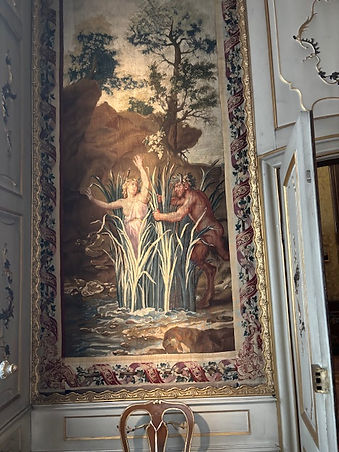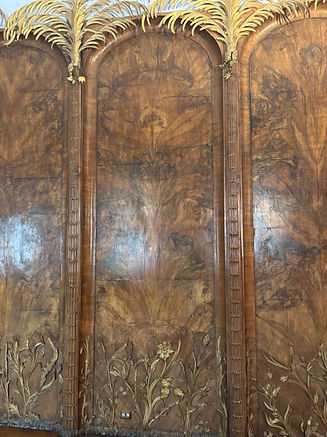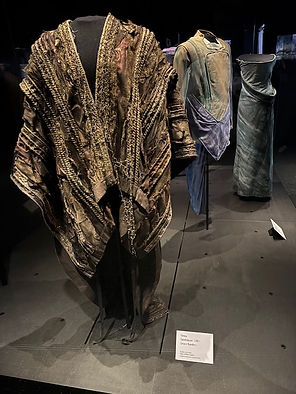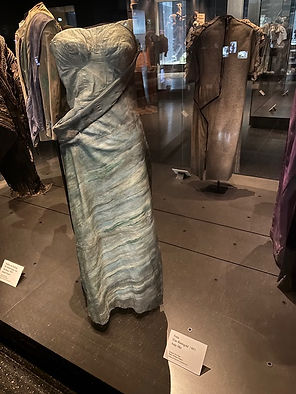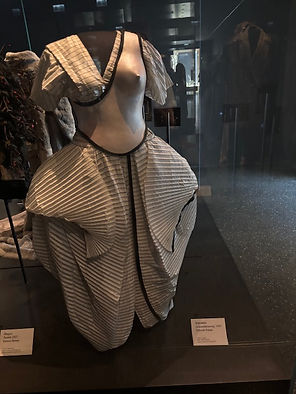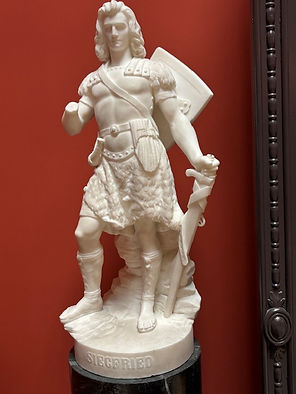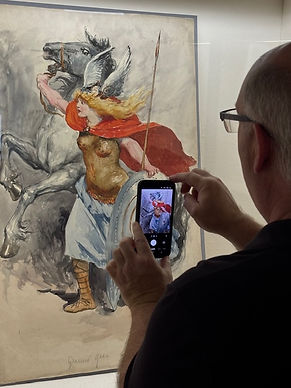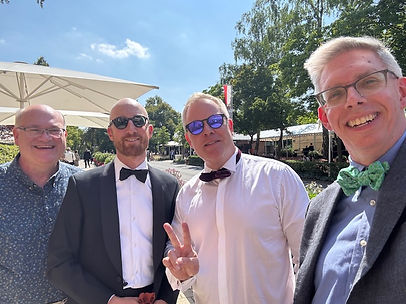

SUN AUG 10
This was the day of our performance at the Wagner Festival. We woke up early and had breakfast in the hotel restaurant, where that beleaguered woman was in charge. She was significantly less beleaguered now that we weren’t bothering her but she always had an undercurrent of beleaguerity. Breakfast was very nice: eggs, cold cuts, cheese, rolls and croissants with butter, jam, honey, and faux Nutella, yogurt, cereal, coffee, and juice.
Divas covered at breakfast:
Eva and Zsa Zsa Gabor (they always go together)
Debbie Reynolds
Barbra Streisand
We walked down to the Wagner Museum, which is housed in his former house. But first we checked out the New Palace, built in 1753 by Margrave Friedrich von Brandenburg-Bayreuth with major input by his wife Wilhelmine. It was gorgeous and we had possibly more fun than was intended. Check out this tapestry:
Scott: “There’s a lot going on here. The shields hanging on the tree, indicating that the battle is over, the angels coming down from heaven, and a couple of cute little dragons over on the left. A little bit of everything.”
This room had amazing gilded decorations. I invented instructions from the lady of the house to the man doing the gilding.
Lady of the House: “My husband would very much appreciate it if the woman on the ceiling had her boob out. Just one boob. And one foot. The left foot please, he would not like to see the right foot. Thank you.”
This parquet floor was beyond:
More invented dialogue for this tapestry:
Woman: “That horny ass centaur is onto my scent! I’ll hide in these tall weeds. Oh no, he found me! I never should have put my boob out.”
This palm hallway was something else:
I’ll quote from the display card: “The elongated Palm Room is not only one of the most original and important rooms of the Palace of Bayreuth, it is also one of the highlights of the southern German rococo style. Visitors feel like they are in a palm forest.”
[Speak for yourself]
“The plinth area features delicately carved grasses, stalks, and blossoms. [I added the serial comma.] The golden treetops heavy with fruit lean elegantly into the room. The wall sections between the palm trees are panelled with the finest heavily grained walnut wood that gives the impression that you are looking into the thicket of a forest.”
[For real? Are you high?]
“The console tables on the window side look like gnarled laurel trees. [So does your butt.] In the sky you see magical birds circling, flying fish, winged snakes, and graceful dragons. [Again with the serial comma.] Once again, China has been brought to life in Bayreuth!”
Clearly they hired a most amusing writer to do these display cards.
I didn’t think I’d be into a room of miniatures but they were pretty amazing. This was only three inches tall, unbelievable.
We decided this well-appointed matron would be played by Margaret Dumont in the movie:
OK enough fun there! The Wagner Museum is behind the New Palace, through a lovely park. The house is surprisingly small.
His grave is nearby:
The first stop on the museum tour had costumes on display. Here are (left to right):
Grace Bumbry as Venus in *Tannhäuser* (1961)
Anja Silja as Freia in *Das Rheingold* (1965)
Gwyneth Jones as Venus in *Tannhäuser* (1972)
Hanna Schwartz as Fricka in *Das Rheingold* (1976)
Deborah Polaski as Brünnhilde in *Götterdämmerung* (1994)
Waltraud Meier as Isolde in *Tristan und Isolde* (1993)
And last but not least, a female chorus member in the notorious 2010 production of *Lohengrin.*
Next was Wagner’s home, Wahnfried (German for “freedom from illusion”). The entrance hall had small white marble sculptures of some of the heroes from his operas. Only the men, all of them gorgeous. Sends a message, am I right? Here’s Lohengrin:
Siegfried had used his right hand so much that it fell off. He should have listened to his mother.
The exhibits had a lot of what Scott called “creepy relics.” I understand the value of a conducting baton that Wagner had used, and his famous velvet beret, but do we need to see his coin purse?
Wagner's primary patron for much of his career was Mad King Ludwig of Bavaria. The nature of their relationship is difficult to ascertain but if you connect the dots it seems pretty clear that Ludwig had a thing for Wagner and that Wagner encouraged that (he was a master at exploiting people). Ludwig was quite lovely himself:
I think the creepiest of the creepy relics was this small box that had a miniature of Ludwig and a lock of Wagner’s hair. I don’t know who owned this, I’m not sure I want to know.
These ornaments were used in the first Ring cycle in 1876. You can see the bicep bracelet (along the top of the display case) being worn by Brünnhilde in this etching:
One of our favorite exhibits was of paintings by Hans Thoma of costumes designed by Arpad Schmidhammer for Cosima Wagner’s 1896 production of The Ring Cycle. Each display had the painting and a photo of the singer in the role. Scott pointed out that the paintings don’t just show the vibrant use of color, they also depict the movement and drama in a much more satisfying way than a still photo, which would have required the subject to be perfectly still.
That's Loge, Sieglinde, Wotan, and Brünnhilde. And Scott.
We had a quick lunch at Baeckerei Brunner, a second location of a place we had seen the day before. Interesting that the handsome young man who was working at the other place was working at this one the next day. Was he following us? We split a ham sandwich and some sort of berry pastry. The woman who took our order didn’t speak any English but was very obliging. You can communicate a lot in a few words of German and lots of charades.
We went back to the hotel and changed into our Operkleider. Scott had found a different way to get to the Festspielhaus by bus, hopefully not to the employee entrance this time. We saw two nice looking guys about our age at the bus stop, both wearing black tie. I said, in German, “You’re going to the Festspielhaus?” They laughed and answered in English, "Where else would we be going, dressed like this?" We got on the bus together and were talking non stop for the next half hour.
Their names were Lionel and Boris. They’re Swiss - - one of them lives in Zurich, I didn’t understand where the other one lives. They used to work together in finance but then Lionel, according to Boris, “defected.” Lionel got a job in landscape architecture. Which only makes him cuter. It appeared that they were like me and Scott, two gay guys who are good friends, out on an opera excursion having a fun time.
They saw *Flying Dutchman* on a previous trip to Bayreuth and were in the front row, remarkably close to the stage. Boris said the singer playing the Dutchman came to the very front of the stage to sing his big entrance aria “and he was so close I could smell his breath.” He said there was one major advantage to being so close to the stage: there’s no air conditioning in the auditorium but the stage IS air conditioned, “because they don’t care about the audience members but I suppose they don’t want the singers to die.” Anyway, sitting close to the stage you get some of that AC spilling in your direction.
Here’s a picture of the four of us. Lionel is on the left, Boris is making the V with his fingers.
We walked around a bit and parked ourselves on a bench for a wonderful bit of people-watching. I was surprised to see so many men in black tie - - probably between a quarter and a third of the men were in black tie. And the women they were with were in something resembling a gown. This is one of the few situations where women have it easier than men because a woman can wear a sleeveless light dress with no stockings and look very elegant whereas black tie means a shirt, a bow tie, a jacket, long pants, socks, and lace-up shoes.
There was a wide variety of dress. Some guys wore variations on what we were wearing: a shirt and a lightweight jacket, maybe a tie. Making the effort but not going all out. I saw a few guys in more or less a T-shirt and jeans. They were let in though no one spoke to them or even looked at them. One guy was wearing a tuxedo jacket with no shirt under it, displaying a full complement of shag carpet chest hair. He also had a bag covered in dark green sequins. I don’t remember the pants or the shoes but it was a whole lot of look. He owned it, his outfit was NOT wearing HIM.
Scott pulled an overview of *Tristan* out of his jacket pocket but decided it was easier for me to tell him the story. My summary was shorter and more amusing. I imagine the summary he found online didn’t use the words “gal pal,” “wing man,” or the phrase “Isolde’s going to get her nightie on” but I wouldn’t be surprised if both our summaries used the term “erotic frenzy.” It’s sort of baked into the piece. Try describing basketball without using the word “dribbling.”
We showed our tickets to an usher and she asked to see ID, to confirm that we had the same names as the people on the tickets. I’ve never encountered that anywhere else. We went over to the cloakroom and picked up two seat cushions. Scott took this cute pic of me as we were about to go upstairs to our seats.
We walked up, up, and up to the gallery, the upper balcony. The air was rare up there! Our seats weren’t together, I was in seat 9 and Scott in 15. We were greatly annoyed that we had an obstructed view, a column directly ahead of us, blocking about a third of the stage. This was not disclosed on the website when I bought the tickets. The same thing happened when I saw *Lohengrin* in Munich in 2019. In the US you would be alerted to this, you might even be given a photo of what your view would be, and of course the ticket price would be substantially less than a seat with an unobstructed view. Ah well, what could we do about it. I made the same alteration of expectations as I had done in Munich - - I decided the obstruction was part of the director’s concept, like in this John Baldessari painting in which he covered up what everyone was looking at:
I’ll remind you that the day before we left New York we had dinner with John, David, and Karen and John filled us in on a lot of the peculiar Bayreuth customs. First off, no one sits down until everyone in the row has taken their place. People can only enter from one end of the row so this makes sense and prevents a lot of up and down and waiting. Our row did a variation on this theme: if the far end of the row had everyone there they would sit down, but then everyone to the left of an empty seat would remain standing until that seat was filled. Rinse and repeat.
I had a gap between my seat and the next seat to the right, about a foot wide. I suppose this was to avoid someone sitting in a spot that was completely obstructed. The guy to my right had been to this rodeo before - - he took off his jacket and hung it off the armrest on the left so it was hanging into that open area. I did the same with my jacket, on the right. I should mention that you’re not allowed to put anything on the floor (I think it’s an acoustical issue).
There are two rows of lighting fixtures in the auditorium below. At some point the globes in the fixtures on the upper row went out. Then a minute or so the globes in the lower row slowly dimmed to nothing. This dimming was a signal to the ushers to close the doors to the exit and LOCK THEM. Yes, the doors were locked. John warned us about this, and I’m glad he did because if not it would have been triggering for me, a fan of horror movies. The usher also pulled aside the curtain leading to the door so we were visually no longer aware of there even being a door.
Almost every opera performance I’ve attended starts with silence and then applause for the conductor entering the pit. The conductor turns to the audience, accepts the applause, turns to the orchestra, and gets things going. The Festspielhaus has a hood over the orchestra pit so we had no way of telling when the conductor walked into the pit. This invisible, surprise start adds to the hypnotic spell of the performance. The prelude to *Tristan* starts quietly but conductor Semyon Bychkov had the cellos playing so quietly that I couldn’t hear their first note. The start of the opera crept up on me.
This is the opening sequence of the creepissimo Lars Von Trier movie *Melancholia.* It uses the prelude to *Tristan und Isolde* and is maybe the most perfect union of film and music I’ve ever seen:
Here’s the thing about Wagner: the harmonies and the orchestration combine to do something unlike any other music. I describe it as a narcotic effect. That effect is heightened at Bayreuth because the theater is made out of wood and the hooded orchestra pit throws the sound of the orchestra onto the stage, so the sound is “mixed” by the time it comes to you. I’ve heard close to twenty Wagner performances and nowhere was the music more luminous and sensual. Bychkov had a lot to do with that but it was also the theater itself.
Wagner is known for being loud but Bychkov never indulged in this. The singers sometimes sang full out but we never for a moment felt like they were doing that in an effort to sing over the orchestra - - the orchestra supported them, they never covered them.
John had told us to look out for the “Bayreuth Bray,” the super loud sort of growling sound that the brass sometimes makes, only at Bayreuth. They’re buried way down in the covered pit and they have to really wail in order to get themselves across. John told us they’re replaced by a new set of brass players for the final act - - the other players are plum tuckered out. I heard just one moment of Bayreuth Bray, at the start of the second act, when the French horns are doing their hunting routine. It made me smile.
Let’s talk about the singers. Camilla Nylund was Isolde. I had a hunch I had heard her before and sure enough she had been the Isolde in a concert performance of Act II at Carnegie Hall back in 2018 with Andris Nelsons conducting the Boston Symphony Orchestra and Jonas Kaufmann as Tristan. Here’s what I said about her: “Of all the singers, I have the hardest time imagining her in the role. Her voice is essentially delicate in color, perfect for the Marschallin in *Der Rosenkavalier* but it wouldn’t work for Isolde. She sounded great in the second act, she does her most lyrical singing in that act, but I doubt that Nylund could make it through Isolde’s blazing first act narration and curse.” Well either I was all wrong back then (entirely possible) or her voice has changed in the last seven years. She was an extraordinary Isolde, blazing when she needed to be (her narration and curse were sensational) but a sensitive and lyrical performance on the whole.
Andreas Schager was Tristan. His voice was loud most of the time, that might just be the way he’s wired. I was worried in the first two acts because he sang out of tune more than I’d like - - both sharp and flat, he had an equal opportunity intonation problem. But I can forgive a lot when it comes to a Wagner tenor, the important thing is that you never sound tired or make the audience feel like you’re not going to make it to the end. These operas are tests of stamina, pacing is one of the top issues. I wasn’t worried about him in that way, I knew he could do it.
The third act starts with a long mostly solo scene for Tristan, he’s dying and going a little nutty. I’ve heard three other Tristans and in each case this scene was long and boring. Schager blew me away, his singing was endlessly varied, tied to the text, and full of nuance and deep feeling. I didn’t know he had it in him. His singing of that scene was revelatory.
Gunther Gröissböck was King Marke. I’ve heard him a handful of times at the Met, I’m always pleased to see his name on the cast list. I should mention that he’s my next boyfriend - - he’s incredibly handsome and hunky and what a gorgeous voice.
He’s sung quite a lot at Bayreuth and as a bass at 50 years old, he could have many more years in his future. His long second act aria is the test in this role and while he wasn’t as thrilling as Rene Pape neither was he a total snooze like a couple other Markes I’ve heard. He kept me engaged in this scene but didn’t exactly set the joint on fire.
Ekaterina Gubanova was Isolde’s gal pal, Brangäne. She had the whole package, a creamy middle voice, an exciting top voice, and a melting, luscious second act aria, maybe the most beautiful music in the opera. I heard her in this role at the Met in 2016 so she was no surprise.
The biggest surprise of the night was baritone Jordan Shanahan as Tristan’s wingman Kurwenal. This character has a tendency to fly under the radar, he doesn’t have much to do and typically doesn’t make much of an impression. Well, Shanahan had other plans. I hadn’t ever noticed how much his character sings in the third act, in the rare moments when Tristan isn’t singing. Shanahan poured out gallons of gorgeous, rich, amber-hued voice, I literally sat up and took notice. You’ll remember that Schager’s Tristan was the real winner in this scene but he was brilliantly supported by Shanahan. He’s the real deal, I’ve got my eye on him.
It’s complicated for me to explain my thoughts on the production. First off here’s a trailer made for the premiere in 2024:
The production wasn’t a total win but neither was it a misfire. It didn’t contribute much but then neither did it get in the way. This is sadly about all you can ask for a Wagner production these days. Director Thorleifur Örn Arnarsson set it in a sort of steampunk junkyard, lots of rusty metal pipes, wooden rigging, ropes, and what Scott called “detritus”: chairs, bits of statuary, an old leather globe, a 1940s radio, and did I see a stuffed dog? We ran into a blowhard old English dude in our hotel restaurant the next morning and he had amusing and enlightening things to say about the staging: “I was sitting next to a French gentleman and when the lights came up after the first act, I asked him, ‘Where is this supposed to take place?’ He said, ‘We are everywhere and we are nowhere.’ “ His take on the production on the whole was that it was supposed to be “Isolde’s phantasm.” OK why not. It didn’t really work for me. I’ll be keeping an eye out for Arnarsson’s name but only in an effort to avoid him.
Scott took this picture of the bows:
One other thing I’ll say about the Bayreuth experience: there were no supertitles, very unusual in this day and age. An opera performance almost always has a translation projected either above the stage or on a small screen in front of you (at the Met). There are no titles at Bayreuth which adds to the mystical aura of the experience. You don’t know what they’re singing about every second (unless you speak German or are intimately familiar with the libretto) so it taps into your imagination on a deeper level. I might be switching off the titles when I see *Tristan* at the Met this coming season.
I need to mention the food before we leave the Festspielhaus! The two intermissions are unusually long, about an hour each. This is so the audience can have dinner, walk around, cool off, and build up their nerve for the next act. John warned us that you have to fly out of the theater and get in line for food because they run out! We can’t have that! There are a number of dining options and we chose the cafeteria style scenario. The line moved moderately fast, I bet we were in line for only about 15 minutes. We both had a cold bowl of mixed stuff: rice, sliced cucumbers, edamame, chickpeas, and skinny slices of carrot. Scott’s also had a couple of spears of grilled chicken and mine had eight nice-sized chunks of tofu. Both were topped with two big slices of what appeared to be pickled yellow radish. I also got a Coke Zero (it worked because I slept very little in the second and third acts) and we split a pretzel. This is Bavaria, after all.
We were overlooking some sort of employee patio. We had a hard time figuring out who they were…
They weren’t stagehands, they weren’t wearing black. They weren’t clerical because they wouldn’t be there during the performance. They were all different ages, a mixture of male and female, a few smokers. We decided they were probably the orchestra. And they can dress comfortably because no one ever sees them. Except when they’re eating and smoking during intermission.
We had dessert in the second intermission: a shallow slice of chocolate cake topped with a few lingonberries, a small round cake that we couldn’t quite identify, and we split a rhubarb soda. The small round cake was on a blond cookie crust. The cake was a faintly tasty vanilla cake but as we got deeper into it we found make some bits of pear in the center…? And maybe the pear had been soaked in booze…? This cake was a lesson in reserving judgment.
Two last pictures before we leave the festival grounds. A picture I took of the two of us on the plaza and a picture Scott took of all those other people. BTW the pictures I'm using throughout this travelogue are a mixture of my pictures and Scott's.
We walked home, it was a lovely night.
My final word on Bayreuth: I was thrilled to be there, it was a fascinating and deeply meaningful experience, but do I need to go back? I’d love to see my beloved *Lohengrin* and it would be fun to see *Das Rheingold* because the quiet E flat major prelude has a way of coming up out of the floorboards. But that would require lots of cash to sit in that area. I’ll think about it, maybe in a couple years I’ll be eager to go back.
And this is hard to articulate but there was something off-putting, for me, about the atmosphere of extreme seriousness and reverence and the fossilized tradition. It had a Germanic way to preventing me from having a good time.




